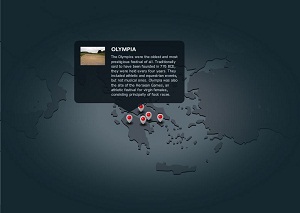3 The broader context: Other athletic festivals in Ancient Greece
Olympia was not the only place to host sporting games in Ancient Greece. The Greeks were passionate about athletic festivals, and different cultural manifestations of the athletic spirit could be found in many regions of the Hellenic world. In the 6th and 5th centuries BCE, as the influence and cultural impact of the Olympics were consolidated, other major athletic festivals began to emerge, each held at a different location under the patronage of one of the Greek gods. Three of the more important festivals were the Isthmian Games (named after the Isthmus of Corinth, held in honour of Poseidon, the Nemean Games (held at Nemea in honour of Zeus) and the Pythian Games (held at Delphi in honour of Apollo).
These three major festivals, along with the Olympics, are collectively known as the Panhellenic (i.e. all-Greek) Games, in reference to the breadth and depth of their cultural impact within the Greek world. They were also referred to in Ancient Greece as the Periodos (i.e. circuit) Games, because their starting dates were organised in a way that avoided clashing with each other, thereby allowing athletes, as well as the more avid spectators, to attend a different game every year if they wished to. The Nemean and Isthmian Games were held both the year before and the year after the Olympic Games; the Pythian Games were held between the Nemean and Isthmian Games (on the third year of each Olympiad cycle).
| Year 1 | Olympics (July - August) |
| Year 2 | Nemean (July - August) |
| Isthmian (April - May) | |
| Year 3 | Pythian (July - August) |
| Year 4 | Olympics (July - August) |
| Year 5 | Nemean (July - August) |
| Isthmian (April - May) | |
| Year 6 | Pythian (July - August) |
Footnotes
The Panhellenic cycle. Note that July and August come before April and May. This is because the Attic calendar started after the summer solstice. July – August was their first month, which was called Hekatombaion.The Panathenaic Games, held in Athens every four years, were also grand in scale and culturally significant. However, they were not considered a Panhellenic festival. They were sporting events held as part of the local Panathenaia religious celebrations, which were organised in honour of the city’s patron goddess, Athena. The Panathenaic Games were distinctive in that athletic victors were awarded emblematic large vessels (known as Panathenaic amphorae) full of olive oil, which was a valuable commodity. The Heraean Games also had a very distinctive aspect; only virgin females could compete. These games were held at Olympia in honour of Hera (Zeus’s wife). Victors were awarded a wreath of wild olive and given the privilege of setting up their effigy in the Temple of Hera (within the sacred grove of Olympia).
By the Hellenistic period, hundreds of other minor sporting events were dotted across the Greek world. These smaller festivals (e.g. the Soteria Games of the Aetolians, the Sebasteia Games of Judaea or the Nikephoria Games of King Eumenes II of Pergamon (one of his letters can be seen here [Tip: hold Ctrl and click a link to open it in a new tab. (Hide tip)] )) varied significantly in structure, ethos and duration. For most of Ancient Greek history, they were eclipsed by the cultural impact and significance of the Olympics, which were by far the largest and most popular athletic festival. However, these minor sporting events played an important role during the later Roman period, when the Games were banned by Theodosius I. Because they were less prominent and more geographically spread out, they were harder to suppress and therefore succeeded in keeping the ancient athletic spirit alive for some time, years after the Olympics had ceased to be.
Interactive presentation
This interactive presentation will give you the locations and details of the Panhellenic, Panathenaic and Heraean Games.

